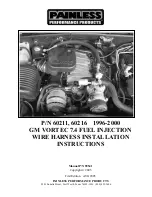
If the ignition key is cycled, this sequence will repeat,
providing the system fault still exists. If the system fault
no longer exists, the Tire Pressure Monitoring Telltale
light will no longer flash, and the
⬙
CHECK TPM SYS-
TEM
⬙
message will no longer display, and a pressure
value will display in place of the dashes. A system fault
can occur due to any of the following:
1. Jamming due to electronic devices or driving next to
facilities emitting the same radio frequencies as the TPMS
sensors.
2. Installing some form of aftermarket window tinting
that affects radio wave signals.
3. Lots of snow or ice around the wheels or wheel
housings.
4. Using tire chains on the vehicle.
5. Using wheels/tires not equipped with TPMS sensors.
NOTE:
1. The compact spare tire does not have a tire pressure
monitoring sensor. Therefore, the TPMS will not monitor
the pressure in the compact spare tire.
2. If you install the compact spare tire in place of a road
tire that has a pressure below the low-pressure warning
limit, upon the next ignition key cycle, the TPMS Telltale
light will remain on and a chime will sound. In addition,
the graphic in the EVIC will still display a flashing
pressure value.
3. After driving the vehicle for up to 20 minutes above
15 mph (25 km/h), the TPMS Telltale light will flash on
and off for 75 seconds and then remain on solid. In
addition, the EVIC will display a
⬙
CHECK TPM SYS-
TEM
⬙
message for three seconds and then display dashes
(- -) in place of the pressure value.
350
STARTING AND OPERATING
Summary of Contents for 2010 Journey
Page 2: ......
Page 5: ...1 INTRODUCTION 5...
Page 8: ......
Page 174: ......
Page 180: ...INSTRUMENT CLUSTER 180 UNDERSTANDING YOUR INSTRUMENT PANEL...
Page 290: ......
Page 332: ...332 STARTING AND OPERATING...
Page 386: ...Jack Engagement Locations 386 WHAT TO DO IN EMERGENCIES...
Page 470: ......
Page 481: ...INDEX 10...
















































